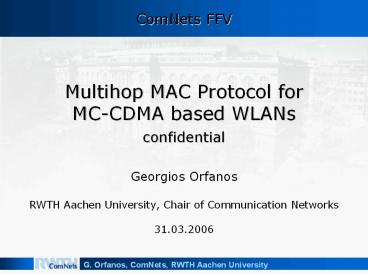Multihop MAC Protocol for MC-CDMA based WLANs confidential - PowerPoint PPT Presentation
1 / 16
Title:
Multihop MAC Protocol for MC-CDMA based WLANs confidential
Description:
ComNets FFV Multihop MAC Protocol for MC-CDMA based WLANs confidential Georgios Orfanos RWTH Aachen University, Chair of Communication Networks 31.03.2006 – PowerPoint PPT presentation
Number of Views:70
Avg rating:3.0/5.0
Title: Multihop MAC Protocol for MC-CDMA based WLANs confidential
1
Multihop MAC Protocol forMC-CDMA based
WLANsconfidential
ComNets FFV
- Georgios Orfanos
- RWTH Aachen University, Chair of Communication
Networks - 31.03.2006
2
Outlook
- MC-CDMA
- C-DCF
- Smart Backoff
- Parallel transmission
- MAC layer relaying function
- Multihop guard interval, extended NAV
- Simulated scenario and parameters
- Simulation results
- Comparison with DCF
- Conclusions
3
MultiCarrier Code Division Multiple Access
- Combination SS and OFDM
- Frequency spreading
- Frequency diversity
- IFFT / FFT realization of multicarrier modulation
- Multipath robustness
- Cyclic prefix
- Simultaneous transmissions in the same frequency,
through division of the spectrum in parallel
channels gt codechannels - Spreading factor 4
4
C-DCF
- CSMA / CA with 4 parallel codechannels
- multichannel system
- Selection of codechannel
- random
- first transfer on cch1
- Data transfer DCF
- NAV per codechannel
- each station monitors optionally one or all
codechannels - Power control over RTS / CTS
- for all data frames
5
Smart Backoff
- Backoff procedure spanning over many cchs
- Backoff Time Random aSlotTime
- Another cch seems idle
- Another cch is determined idle
- No cch is idle
6
Parallel transmission
- 1 codechannel 1/4 of frequency channel capacity
- Parallel (multichannel) transmission for high load
7
MAC layer relaying function
- Multihop connections up to 3 hops
- Fig. multihop connection from station 1 to
station 4 - Multihop packet handled per station as own packet
- MAC header contains the addresses of all
forwarding stations - Spatial reuse possible
Mac frame Format
2
6
6
6
6
2
6
0-2312
4
Frame Control Duration/ ID Address 1 Address 2 Address 3 Sequence Control Address 4 Frame Body FCS
8
Multihop guard interval, extended NAV
- Multihop guard interval to prioritize forwarder
- Duration of one complete transmission window
- Smart Backoff at forwarders for bottleneck
avoidance - Combined with parallel transmission
- Extended NAV
- Duration, cch, MSs
9
Simulated scenario and parameters
Parameter Value
Max. TxPower 17dBm
Spreading Factor 4
Cwmin 31 slots
Cwmax 255 slots
Number of Subcarriers 48 Data 4 Pilot
Subcarrier Spacing 0.3125 MHz
Channel Bandwidth 20 MHz
Carrier Frequency 5.25 GHz
Noise Level -93dBm
Path loss Factor 3.5
TxRate Data 12 Mbps
TxRate Control 12 Mbps
RTS/CTS enabled
Symbol Interval 4 µs 3.2 µ 0.8 µs
Guard Interval 0.8 µs
Preamble 16 µs
Max. Propagation Delay 0,15 µs
PDU Length 1024 Byte
10
Simulation results (I)Mean values
- Achievable throughput allies with theoretical
calculation 2,5 Mbit/sec/cch - Depends on number of hops
11
Simulation results (II)CDF of delay per hop
- left 1,25 Mbit/sec
- right 0,75 Mbit/sec (saturation throughput)
12
Simulation results (III)CDF of end-to-end delay
per connection
- left 1,25 Mbit/sec
- right 0,75 Mbit/sec (saturation throughput)
13
Comparison with DCF (I)Throughput
14
Comparison with DCF (II)End-to-end delay
15
Conclusions
- Multihop guard interval
- prioritizes the relaying MS on medium access
- reduces the end-to-end delay of the multihop
connection - Smart Backoff at forwarding MSs
- reduces the medium access time
- enables parallel transmission in many cchs, that
increases the available capacity and reduces the
bottleneck effect. - In multi-channel, multihop environments applying
carrier sensing NAV timer per cch (channel) is
not enough - the cch specific NAV per cch and MS proposed is
then necessary.
16
- Thank you for your attention !
- Georgios Orfanos
- orf_at_comnets.rwth-aachen.de
- Any questions?






























